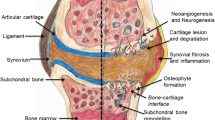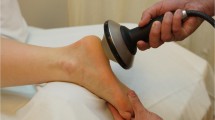Abstract
Purpose
The aim of this study was to investigate whether the effects of extracorporeal shock wave therapy (ESWT) could affect the behavior of primary cultured human tenocytes over a 12-day period.
Methods
In this controlled laboratory study, primary human tenocytes were established from semitendinosus tendons collected from 3 patients undergoing arthroscopic anterior cruciate ligament (ACL) reconstruction. Cell viability, overall cell morphology, cell proliferation, and collagen synthesis following ESWT have been evaluated.
Results
ESWT significantly interferes with the overall cell morphology, by impairing dedifferentiation of the cells. Furthermore, a shock wave-mediated growth-promoting effect was measured by the MTT (tetrazolium) colorimetric assay and by the proliferation marker Ki67. Lastly, a significant increase in collagen (mainly type I) synthesis by ESWT-tenocytes compared with control cells was found.
Conclusions
Shock wave treatment promoted cell growth and collagen synthesis of primary cultured human tenocytes. The clinical benefits of ESWT may be ascribed to an increased efficiency of tendon repair after injury.






Similar content being viewed by others
References
Bayreuther K, Rodemann HP, Hommel R, Dittmann K, Albiez M, Francz PI (1988) Human skin fibroblasts in vitro differentiate along a terminal cell lineage. Proc Natl Acad Sci USA 85:5112–5116
Bernard-Beaubois K, Hecquet C, Houcine O, Hayem G, Adolphe M (1997) Culture and characterization of juvenile rabbit tenocytes. Cell Biol Toxicol 13:103–113
Berta L, Fazzari A, Ficco AM, Enrica PM, Catalano MG, Frairia R (2009) Extracorporeal shock waves enhance normal fibroblast proliferation in vitro and activate mRNA expression for TGF-beta1 and for collagen types I and III. Acta Orthop 80:612–617
Bihl G, Meyers A (2001) Recurrent renal stone disease-advances in pathogenesis and clinical management. Lancet 358:651–656
Chao YH, Tsuang YH, Sun JS, Chen LT, Chiang YF, Wang CC, Chen MH (2008) Effects of shock waves on tenocyte proliferation and extracellular matrix metabolism. Ultrasound Med Biol 34:841–852
de Mos M, van El B, DeGroot J, Jahr H, van Schie HT, van Arkel ER, Tol H, Heijboer R, van Osch GJ, Verhaar JA (2007) Achilles tendinosis: changes in biochemical composition and collagen turnover rate. Am J Sports Med 35:1549–1556
Denaro V, Ruzzini L, Barnaba SA, Longo UG, Campi S, Maffulli N, Sgambato A (2011) Effect of pulsed electromagnetic fields on human tenocyte cultures from supraspinatus and quadriceps tendons. Am J Phys Med Rehabil 90:119–127
Denaro V, Ruzzini L, Longo UG, Franceschi F, De Paola B, Cittadini A, Maffulli N, Sgambato A (2010) Effect of dihydrotestosterone on cultured human tenocytes from intact supraspinatus tendon. Knee Surg Sports Traumatol Arthrosc 18:971–976
Endl E, Steinbach P, Scharfe J, Fickweiler S, Worle K, Hofstadter F (1996) Cell-type-specific response to shock waves of suspended or pelleted cells as analysed by flow cytometry or electrical cell volume determination. Ultrasound Med Biol 22:515–525
Eriksen HA, Pajala A, Leppilahti J, Risteli J (2002) Increased content of type III collagen at the rupture site of human Achilles tendon. J Orthop Res 20:1352–1357
Furia JP (2006) High-energy extracorporeal shock wave therapy as a treatment for insertional Achilles tendinopathy. Am J Sports Med 34:733–740
Gravel M, Iliescu A, Horth C, Apuzzo S, Gros P (2010) Molecular and cellular mechanisms underlying neural tube defects in the loop-tail mutant mouse. Biochemistry 49:3445–3455
Gungormus C, Kolankaya D (2008) Characterization of type I, III and V collagens in high-density cultured tenocytes by triple-immunofluorescence technique. Cytotechnology 58:145–152
Han SH, Lee JW, Guyton GP, Parks BG, Courneya JP, Schon LC (2009) J.Leonard Goldner Award 2008. Effect of extracorporeal shock wave therapy on cultured tenocytes. Foot Ankle Int 30:93–98
Herskind C, Johansen J, Bentzen SM, Overgaard M, Overgaard J, Bamberg M, Rodemann HP (2000) Fibroblast differentiation in subcutaneous fibrosis after postmastectomy radiotherapy. Acta Oncol 39:383–388
Hofmann A, Ritz U, Hessmann MH, Alini M, Rommens PM, Rompe JD (2008) Extracorporeal shock wave-mediated changes in proliferation, differentiation, and gene expression of human osteoblasts. J Trauma 65:1402–1410
Kannus P (1997) Tendons—a source of major concern in competitive and recreational athletes. Scand J Med Sci Sports 7:53–54
Kannus P (2000) Structure of the tendon connective tissue. Scand J Med Sci Sports 10:312–320
Longo UG, Lamberti A, Maffulli N, Denaro V (2010) Tissue engineered biological augmentation for tendon healing: a systematic review. Br Med Bull [Epub ahead of print]
Maffulli N, Ewen SW, Waterston SW, Reaper J, Barrass V (2000) Tenocytes from ruptured and tendinopathic achilles tendons produce greater quantities of type III collagen than tenocytes from normal achilles tendons. An in vitro model of human tendon healing. Am J Sports Med 28:499–505
Maier M, Tischer T, Milz S, Weiler C, Nerlich A, Pellengahr C, Schmitz C, Refior HJ (2002) Dose-related effects of extracorporeal shock waves on rabbit quadriceps tendon integrity. Arch Orthop Trauma Surg 122:436–441
Martini L, Giavaresi G, Fini M, Borsari V, Torricelli P, Giardino R (2006) Early effects of extracorporeal shock wave treatment on osteoblast-like cells: a comparative study between electromagnetic and electrohydraulic devices. J Trauma 61:1198–1206
Orhan Z, Cam K, Alper M, Ozturan K (2004) The effects of extracorporeal shock waves on the rat Achilles tendon: is there a critical dose for tissue injury? Arch Orthop Trauma Surg 124:631–635
Orhan Z, Ozturan K, Guven A, Cam K (2004) The effect of extracorporeal shock waves on a rat model of injury to tendo Achillis. A histological and biomechanical study. J Bone Joint Surg Br 86:613–618
Riley G (2004) The pathogenesis of tendinopathy. A molecular perspective. Rheumatology (Oxford) 43:131–142
Rompe JD (2006) Shock wave therapy for chronic Achilles tendon pain: a randomized placebo-controlled trial. Clin Orthop Relat Res 445:276–277 (author reply 277)
Rompe JD (2007) Repetitive low-energy shock wave treatment is effective for chronic symptomatic plantar fasciitis. Knee Surg Sports Traumatol Arthrosc 15:107 (author reply 108)
Rompe JD, Decking J, Schoellner C, Theis C (2004) Repetitive low-energy shock wave treatment for chronic lateral epicondylitis in tennis players. Am J Sports Med 32:734–743
Rompe JD, Kirkpatrick CJ, Kullmer K, Schwitalle M, Krischek O (1998) Dose-related effects of shock waves on rabbit tendo Achillis. A sonographic and histological study. J Bone Joint Surg Br 80:546–552
Schulze-Tanzil G, Mobasheri A, Clegg PD, Sendzik J, John T, Shakibaei M (2004) Cultivation of human tenocytes in high-density culture. Histochem Cell Biol 122:219–228
Sharma P, Maffulli N (2005) Tendon injury and tendinopathy: healing and repair. J Bone Joint Surg Am 87:187–202
Sharma P, Maffulli N (2006) Biology of tendon injury: healing, modeling and remodeling. J Musculoskelet Neuronal Interact 6:181–190
Speed CA (2004) Extracorporeal shock-wave therapy in the management of chronic soft-tissue conditions. J Bone Joint Surg Br 86:165–171
Stoll C, John T, Endres M, Rosen C, Kaps C, Kohl B, Sittinger M, Ertel W, Schulze-Tanzil G (2010) Extracellular matrix expression of human tenocytes in three-dimensional air-liquid and PLGA cultures compared with tendon tissue: implications for tendon tissue engineering. J Orthop Res 28:1170–1177
Visco V, Bava FA, d’Alessandro F, Cavallini M, Ziparo V, Torrisi MR (2009) Human colon fibroblasts induce differentiation and proliferation of intestinal epithelial cells through the direct paracrine action of keratinocyte growth factor. J Cell Physiol 220:204–213
Vulpiani MC, Trischitta D, Trovato P, Vetrano M, Ferretti A (2009) Extracorporeal shockwave therapy (ESWT) in Achilles tendinopathy. A long-term follow-up observational study. J Sports Med Phys Fitness 49:171–176
Vulpiani MC, Vetrano M, Savoia V, Di Pangrazio E, Trischitta D, Ferretti A (2007) Jumper’s knee treatment with extracorporeal shock wave therapy: a long-term follow-up observational study. J Sports Med Phys Fitness 47:323–328
Widera D, Zander C, Heidbreder M, Kasperek Y, Noll T, Seitz O, Saldamli B, Sudhoff H, Sader R, Kaltschmidt C, Kaltschmidt B (2009) Adult palatum as a novel source of neural crest-related stem cells. Stem Cells 27:1899–1910
Woo SL, Hildebrand K, Watanabe N, Fenwick JA, Papageorgiou CD, Wang JH (1999) Tissue engineering of ligament and tendon healing. Clin Orthop Relat Res 367(Suppl):S312–S323
Yao L, Bestwick CS, Bestwick LA, Maffulli N, Aspden RM (2006) Phenotypic drift in human tenocyte culture. Tissue Eng 12:1843–1849
Conflict of interest
All authors certify they not have signed any agreement with a commercial interest related to this study, and they declare no conflict of interest related to this work.
Author information
Authors and Affiliations
Corresponding author
Additional information
Mario Vetrano and Federica d’Alessandro equally contributed to this work.
Rights and permissions
About this article
Cite this article
Vetrano, M., d’Alessandro, F., Torrisi, M.R. et al. Extracorporeal shock wave therapy promotes cell proliferation and collagen synthesis of primary cultured human tenocytes. Knee Surg Sports Traumatol Arthrosc 19, 2159–2168 (2011). https://doi.org/10.1007/s00167-011-1534-9
Received:
Accepted:
Published:
Issue Date:
DOI: https://doi.org/10.1007/s00167-011-1534-9




